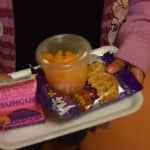

In 1988, I spent some time at this nutrition clinic in Zaire, Africa. Watching malnutrition take hold of a child’s body and mind changes you.
As I have visited schools all across North Carolina, I have watched too much food be thrown away.
And I have realized that it is not just about how many students have access to healthy food through the schools; instead, it is about how many kids are served food in a way that they will actually eat it.
In April, a headline in the Asheville Citizen-Times — Whole grain biscuits? Healthy food a hard sell in WNC schools — sent me reeling.
No Kid Hungry
Hungry students don’t make good learners. When I expressed my frustration to Lou Anne Crumpler with No Kid Hungry, she immediately connected me with James Keaten, executive director of school nutrition services for the Durham Public Schools. At 7:45 early one morning, I met Keaten and the No Kid Hungry team at Spring Valley Elementary School. It was a transformative experience.
For kids, it’s about choice and community
Last year, Keaten participated in the United Way of the Greater Triangle Social Innovation Challenge. The idea was to pilot programs in five schools to increase access to breakfast in a way that students would participate without stigma and while providing a sense of community in the classroom.
Spring Valley Elementary opted to pilot a kiosk-style breakfast. The four kiosks – one for each hallway – cost $1,869 each and 10 insulated bags for milk and juice cost $50.19 each. The other schools increased breakfast participation by 47-78 percent, but the kiosk breakfast at Spring Valley increased participation by 180 percent. Overall, at these five schools, an additional 930 meals per day are served. That’s almost 120,000 additional breakfasts since the grant was implemented.
Just as important, the attendance rate has increased by 1.6 percent at the five schools.
In talking with staff about how to make food work for students, I learned several important lessons. No matter how food service is structured at a school, the principal, the food service manager, the teachers, and the janitors all have to be on board. At Spring Valley Elementary, they are.
The kiosk breakfast model
Meet Sky Harris, the cafeteria manager. Her commitment to this program is exciting. “I love it,” she says. “The kids are so much fun.”
Breakfast starts in the cafeteria as the staff preps the food and loads up the kiosks.
The loaded kiosks are taken to the halls and set up begins.
At 8:30am, the action starts. Keep in mind that all of the students on this hallway will be served in nine minutes. That’s right. Nine minutes.
This is an offer versus serve model. The students pick three items. There is less waste when students are given choice.
Midway through the line, the staff replenishes the food from the kiosk.


Janitors don’t like syrup and milk in the classrooms. They also don’t like the trash going in classroom trashcans. These whole grain waffles are prepackaged with the maple syrup baked in. They are good. I tried them.
Nine minutes later, all the kids have been served, and they are seated in class, eating a healthy breakfast.


The students consumed the food.
The North Carolina State Board of Education adopted a policy that allows breakfast served in the classroom to count as instructional time. The kiosk-style breakfast adds 30 minutes of instructional time to the school day.
The teachers like the fellowship created as the students share breakfast together.
“The students sit down with the people they are going to study with today. That’s a good thing.”
Attendance is taken. The morning announcements take place. Students do morning work. Students read. The teachers have time for one-on-one remediation. Teachers note in a folder which students eat breakfast.
As 9:00am approaches, the students take their trash to the trashcans in the hallway, cleaning up after themselves. A collective calm settles over the classrooms as the students get ready for the school day.


Staff collects the folders with information about how many kids ate breakfast that morning before rolling the kiosks back to the cafeteria.
A Dad brought his son to the classroom. He said, “My school served sausage and egg biscuits. This is better than that. These kids are getting healthy food.”
Whole grain biscuits are served on Fridays, and at this school, they are consumed happily.




Spring Valley Elementary School serves 68.07 percent free and reduced price lunch students. The average daily membership is 604. The average daily attendance is 570. In April 2014, 127 students participated in school breakfast. In April 2015, 436 students participated in school breakfast. This is the leadership team that made this happen: James Keaten, the executive director of the department of school nutrition services; Gwendolyn Wilson, the assistant principal; and Barbara Parker, the principal.

































